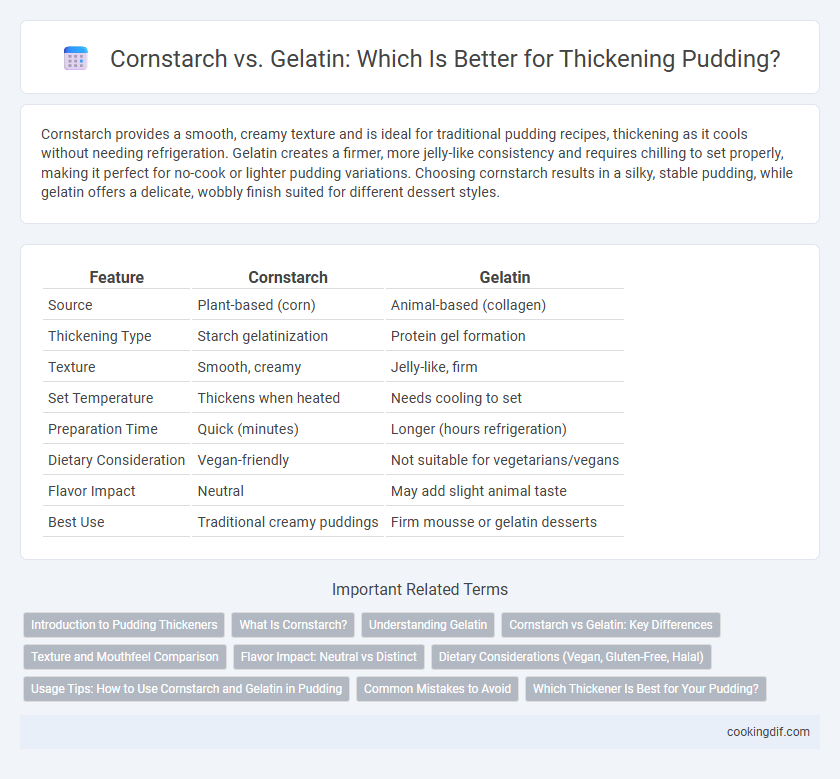Cornstarch provides a smooth, creamy texture and is ideal for traditional pudding recipes, thickening as it cools without needing refrigeration. Gelatin creates a firmer, more jelly-like consistency and requires chilling to set properly, making it perfect for no-cook or lighter pudding variations. Choosing cornstarch results in a silky, stable pudding, while gelatin offers a delicate, wobbly finish suited for different dessert styles.
Table of Comparison
| Feature | Cornstarch | Gelatin |
|---|---|---|
| Source | Plant-based (corn) | Animal-based (collagen) |
| Thickening Type | Starch gelatinization | Protein gel formation |
| Texture | Smooth, creamy | Jelly-like, firm |
| Set Temperature | Thickens when heated | Needs cooling to set |
| Preparation Time | Quick (minutes) | Longer (hours refrigeration) |
| Dietary Consideration | Vegan-friendly | Not suitable for vegetarians/vegans |
| Flavor Impact | Neutral | May add slight animal taste |
| Best Use | Traditional creamy puddings | Firm mousse or gelatin desserts |
Introduction to Pudding Thickeners
Cornstarch and gelatin are popular thickeners used to achieve the ideal pudding consistency, each offering distinct textures and setting properties. Cornstarch creates a smooth, creamy pudding with a slightly opaque appearance, thickening through heat-activated starch gelatinization. Gelatin sets pudding into a firm, jiggly texture, working by protein denaturation and is best used in recipes requiring a stable, chilled set.
What Is Cornstarch?
Cornstarch is a fine, powdery starch derived from the endosperm of corn kernels, widely used as a thickening agent in puddings due to its ability to create a smooth and glossy texture. Unlike gelatin, which is a protein derived from animal collagen and gels by cooling, cornstarch thickens through heat-activated starch granule swelling, making it ideal for hot pudding recipes that require a firm yet creamy consistency. This starch thickens liquids at approximately 95degC (203degF), forming a stable gel upon cooling without the need for refrigeration to set.
Understanding Gelatin
Gelatin is a protein derived from animal collagen, commonly used to create a smooth, gel-like texture in puddings. Unlike cornstarch, which thickens through starch granule swelling, gelatin sets by forming a network of protein strands that trap liquid, resulting in a firmer and more elastic consistency. Understanding gelatin's unique gelling properties helps achieve a creamy yet stable pudding that holds shape better than cornstarch-thickened versions.
Cornstarch vs Gelatin: Key Differences
Cornstarch and gelatin serve distinct roles in pudding thickening; cornstarch creates a smooth, opaque texture by starch granule swelling during heating, while gelatin forms a translucent, gel-like consistency through protein coagulation upon cooling. Cornstarch-based puddings hold shape under heat and have a creamy mouthfeel, whereas gelatin puddings set firmly and provide a flexible, jiggly structure. Understanding these functional properties aids in selecting the right thickener for desired pudding texture and stability.
Texture and Mouthfeel Comparison
Cornstarch creates pudding with a smooth, creamy texture that is slightly opaque and has a velvety mouthfeel, ideal for rich and stable consistency. Gelatin produces a clearer, more elastic pudding with a jiggly, tender mouthfeel, offering a lighter, more delicate texture. Choosing cornstarch results in a denser, more substantial pudding, while gelatin yields a softer, more flexible dessert with a clean finish.
Flavor Impact: Neutral vs Distinct
Cornstarch provides a neutral flavor that allows the natural taste of pudding ingredients to shine without alteration, making it ideal for delicate or fruit-based flavors. Gelatin imparts a distinct, slightly savory undertone and a unique texture, which can influence the overall taste profile of the pudding. Choosing cornstarch preserves the pure flavor, while gelatin adds complexity and a signature mouthfeel that some recipes specifically require.
Dietary Considerations (Vegan, Gluten-Free, Halal)
Cornstarch is a popular thickening agent for pudding that is naturally gluten-free, vegan, and halal, making it suitable for diverse dietary needs. Gelatin, derived from animal collagen, is not vegan or halal, but it is also gluten-free, limiting its use for those avoiding animal products or following halal dietary laws. For plant-based or halal pudding recipes, cornstarch offers a more inclusive and allergen-friendly option without compromising texture or taste.
Usage Tips: How to Use Cornstarch and Gelatin in Pudding
Cornstarch thickens pudding by creating a smooth, creamy texture when heated with liquid, requiring constant stirring and gradual simmering to avoid clumps and achieve the desired consistency. Gelatin, on the other hand, provides a firmer, jelly-like set and must be softened in cold water before gently heating and folding into the pudding mixture without boiling, to preserve its gelling properties. For optimal results, dissolve cornstarch in cold liquid before cooking and allow gelatin to fully bloom to ensure smooth, stable pudding texture.
Common Mistakes to Avoid
Using too much cornstarch when thickening pudding can result in a gummy or pasty texture, so measure accurately and cook with constant stirring to prevent lumps. Avoid overheating gelatin, as excessive heat destroys its thickening properties, and always dissolve it in cold water before adding it to warm pudding mixtures. Mixing cornstarch directly into hot liquids often causes clumping; instead, create a slurry by combining it with a cold liquid before incorporating it into the pudding.
Which Thickener Is Best for Your Pudding?
Cornstarch creates a smooth, glossy texture and provides a stable, pudding-like consistency that holds up well when chilled, making it ideal for traditional creamy puddings. Gelatin produces a firm, jiggly texture with a clear appearance, perfect for light, mousse-like puddings or gelatin-based desserts. Choosing between cornstarch and gelatin depends on the desired pudding texture and stability, with cornstarch best for creamy thickness and gelatin for a delicate, gelled finish.
Cornstarch vs Gelatin for thickening pudding Infographic

 cookingdif.com
cookingdif.com